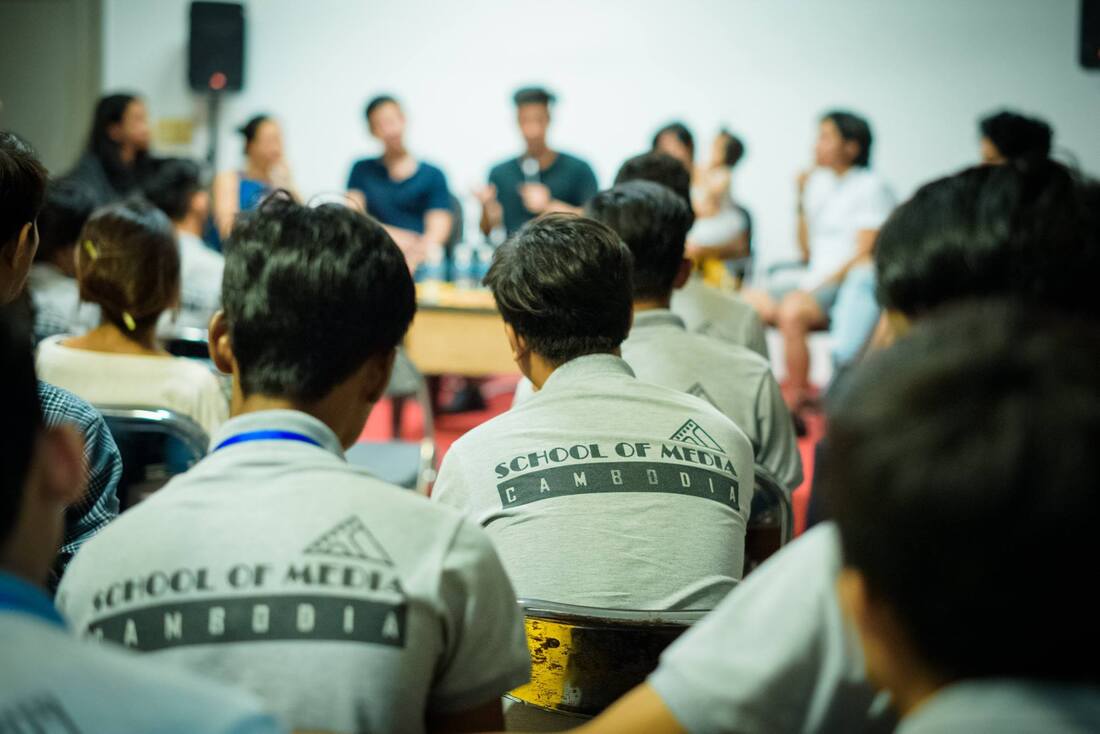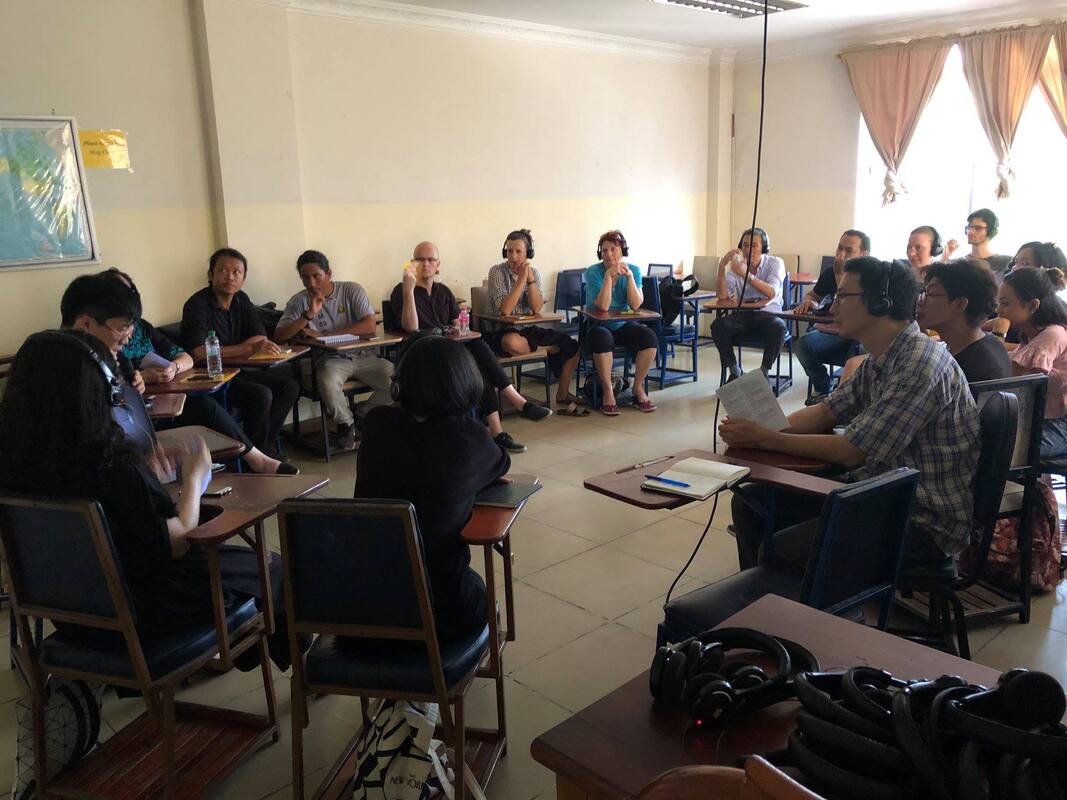22 Mar 2019, 3:00-5:00pm
Venue: Cambodia Film Commission #128, St 200 Map: https://goo.gl/NVm4aT
Venue: Cambodia Film Commission #128, St 200 Map: https://goo.gl/NVm4aT
|
|
“Southeast Asian Cinema”
A panel discussion with filmmakers Nguyen Trinh Thi, Shireen Seno, John Torres, Sompot Chidgasornpongse, Davy Chou,Danech San & Steve Chen, facilitated by Daniel Mattes Join this very special event with an esteemed panel of leading filmmakers from Cambodia, the Philippines, Taiwan, Thailand, and Vietnam.
Somewhere between a sharing of expertise and a conversation about SE Asian cinemas but also an opportunity to ask practical questions about filmmaking, the process, the career path, the possibilities! The panel discussion will follow the overall themes of Currents 2019, placing the thematics of urbanization and development within Southeast Asian cinema today and understanding the participating filmmakers' crossover beyond normal categories of fiction or documentary or experimental. Please join and come with questions! |
29 Mar 2019, 2:00-4:00pm
Venue: Pannasastra University of Cambodia #184, Norodom Blvd (south of Independence Monument), Lecture Hall A, 5F
Map: https://goo.gl/29iixE
Venue: Pannasastra University of Cambodia #184, Norodom Blvd (south of Independence Monument), Lecture Hall A, 5F
Map: https://goo.gl/29iixE
This panel explores different approaches in which urban landscapes are shaped and mediated. Through the disciplines of art, architecture, urban studies and curatorial practice, case studies from Phnom Penh, Kuala Lumpur and Taipei are considered in ways they engage with community building, the public, and the locality.
In Search of Khmer Dwelling Fragments: A Study on Sahakom’s Communal Space and Urban Development in Phnom Penh
by Chhiv Exthai
by Chhiv Exthai
One would simply and narrowly interpret Khmer way of living for just its rural context, in its primitive form, like houses on piles or open living space. Meanwhile,in the urban context, the studies of how we live are usually overlooked. What are the real essences of Khmer living? This paper addresses Phnom Penh urban communities or so called “Sahakom” living in their disconnected history and scattered architectural elements through its dwellers’ narratives. Around the city, from one Sahakom to another, we trace their livings through an architectural survey and examine how the spaces in communities are used. The research finds that in an absence of tenant control system during the return of Phnom Penh dwellers in 1979, small ambiguous “mid-spaces” are organically created between houses during the community formation processes. Those spaces overlap upon each other, creating a kind of communal space inside Sahakom neighborhoods. With this understanding, what are the possibilities of “Sahakom” and urban housing that still maintain our urban communal living?
|
Curating Topography
by Sandy Hsiu-chih Lo One of the core tenets of contemporary art is to believe in the autonomy of art and believe that it will promise a better future world. However, the so-called "art autonomy" has always been constructed with the white box of the museum, based on gaze and reproduction, framed by the author, works, and viewers. The universal truth is closely related to the aesthetics declared by Western philosophy;therefore, the differences in culture, religion, race, gender, class, place, power,
desire, etc. are ignored. At the same time, the pursuit of a better future world echoes utopian ideals or heterotopian imaginations. Utopia or heterotopia is alternative social proposal derived from dissatisfaction with the current reality.Therefore, the key task lies in presenting the differences in the current living situation, to highlight the differentiation in geography, culture, and individual particularity. |
|
The Small Public
by Goh Sze Ying “Politics,” writes Jacques Rancière, “always involves opposing one people to another.” What does it mean for art to be political in an age of a contracting public? More pertinently, what does it take for art in public space to negotiate multiple publics instead of opposing a specific view? Artists who situate their work in public spaces or situations sometimes face challenges from the state or the market in appropriating their tactics into strategies of control and commodification. In response, some have resorted to producing works that are “extra-institutional” and “uncommodified”: these works are often absurd,ephemeral, peripheral. This paper examines the utility of small-scale art interventions in contesting and transforming public space through examples of artists working in Kuala Lumpur across the period of the Bersih rallies in the 2000s.
Against the backdrop of a series of public rallies and growing demands for electoral reforms in Malaysia, some of these site-specific works become a form of disruption which represents a new articulation of change that eludes participation or activities sanctioned by the state or politicos and avoids potentially being subsumed by the market. The multiplicity of interventions offer opportunities --intentionally or otherwise — for contestation, allowing a contracting public to remain plural and political.Paragraph. |
About the speakers
|
Chhiv Exthai
Chhiv Exthai currently studies at the Kyoto Institute of Technology, Department of
Design and Architecture. His research centers on urban communities and architectural history in Cambodia. He was a participant of the Vann Molyvann Project's Summer School (2015). He was the 1st prize winner from Akashi Institute of Technology, Japan for his research project "Sahakom and Communal Space" (2018), and the 2nd price winner of 14th Japanese National Designer Competition (2017). |
Sandy Hsiu-chih Lo
Sandy Hsiu-chih Lo is an independent curator, art critic, art historian, film critic
and documentary filmmaker. Her research interests include theories of the city, philosophical constructions of space, gender politics, contemporaneity in indigenous art and situation knowledge. Her current projects focus on curating as a form of social and spatial practice and critical thinking. She has published several books on Taiwan art history and many art and film critics in various journals and magazines. She is one of the grantees of Asian Cultural Council, 2012, and one of the grantees of National Foundation of Culture and Arts in 2005 and 2015. Among recent major curatorial projects, she is co-curator of “Zhongshan Park Project” of 9th Shanghai Biennale (2012-2013) and one of the curators of 2018 Kuandu Biennale. |
Goh Sze Ying
Goh Sze Ying is an Assistant Curator at the National Gallery Singapore. At the Gallery, she has worked on exhibitions 'Minimalism: Space. Light. Object.' (2018), ‘Lim Cheng Hoe: Painting Singapore’ (2018), ‘Listening to Architecture: The Gallery’s Histories and Transformations’ (2017). Her research focuses on photography in mid-20th century Singapore looking at how photographic practice relates to mobility and identity. Sze completed her MA in urban sociology at Goldsmiths, University of London in 2015; her thesis centered on how publicness is negotiated through temporary artistic occupations in urban public spaces. Formerly based in Kuala Lumpur, her past projects include 'Between States' (2017), 'ESCAPE from the SEA' (2017), ‘The Living City’ (2014), ‘Urban Residency’ (2013).
|







